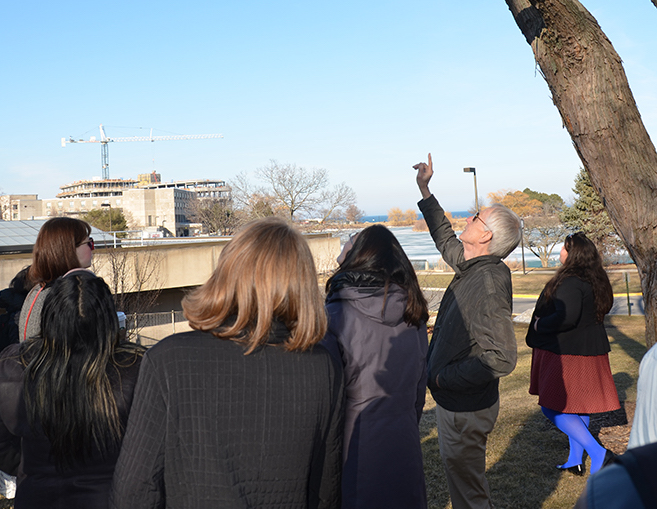
Around 20 Northwestern students and faculty are standing outside of Swift with their arms fully extended, parallel to the ground. They are looking at the trees around them – trying to determine which tree they look like the most. Janie Pochel, member of the American Indian Center of Chicago (AIC), is teaching them how to identify maple trees for the maple sugaring project they began the first week of spring Quarter.
In November 2014, Northwestern’s Native American Outreach and Inclusion Task Force wrote a report, encouraging the university to enhance its relationships with Native Americans. After all, according to the Northwestern Viewbook, only 0.5 percent of the Class of 2018 identifies as “American Indian/Alaska Native.”
To address this complicated relationship, psychology Professor Doug Medin started a new maple sugaring project this Spring Quarter. All while looking at maple sugaring through various Native American perspectives, this project will teach students to identify maple trees, how to tap these trees and how to use the sap for maple candy, sugar or syrup. Native nations from this area have been collecting maple sugar for centuries, using it as an experience to pass on tradition and to build relationships with each other and with the land. As of March 16, 59 people are participating in the program.
“There will be a relationship with the AIC involved, but perhaps more importantly, the people who are leading the program will be presenting the material from a Native American perspective, and that includes a strong emphasis on developing relationships with the rest of nature,” Medin said.
Medin and Anthropologist Dr. Eli Suzukovich had been talking about how most learning happens inside of the classroom, in addition to the issue of Native American foraging rights for years. Medin said they wanted to get students outside for learning and building a relationship between the American Indian Center and Northwestern. This maple sugaring project brought a solution to these concerns by involving both organizations in a traditional Native activity.
AIC community members David Bender, Janie Pochel and Fawn Pochel will be facilitating the project. They all participated as facilitators and general participants in the AIC program and will share their language, stories and experiences of what maple tapping means to their Lakota, Cree, Standing Rock Sioux and Bad River Chippewa cultures.
After the program’s approval, Medin and Suzukovich reached out to students in SEED (Students for Ecological and Environmental Development), EPC (Environment Policy and Cultures), NAISA (the Native American and Indigenous Student Association) and Medin’s Winter Quarter class, Native Americans and Environmental Decision Making.
Students like Weinberg junior Carrie Phillips were excited about learning outside the classroom. She found out about the project through EPC and from Medin’s Winter Quarter class.
“I study a lot about nature in school, but I don’t necessarily spend a lot of time actually in it," said Phillips. "I think that will foster a love of the outdoors and maybe help me see the world around me in a way that I hadn’t noticed before."
Weinberg junior Kirby Barth said she is also looking forward to learning this skill through various Native American lenses and also working directly with a tree species.
“I consider myself an outdoorsy person, and I think there is a lot of value in knowing specific facts about the environment, like knowing specific tree species,” said Barth. “This is another opportunity to learn about that and I think the maple tapping in particular is a way to utilize knowledge about plant species or tree species.”
The program’s orientation on March 12 was the first time the students really learned the extent they would be involved in the maple sugaring. The official start date was the first week of Spring Quarter, but participants who were on campus for spring break began the tapping and collecting of sap.
“I’ll probably put my syrup in a jar and then use it and invite all of my friends over and make pancakes and say ‘look at this cool syrup I made and brag about my experience,” Phillips said.
Once the maple tree’s excess syrup has been exhausted, the project will culminate in a feast at the AIC, something that Medin and the center hope will continue to facilitate the ongoing relationship they have been developing with Northwestern.
Jasmine Gurneau, Northwestern alum and community member and program leader at the AIC, recognizes a need for this developing relationship.
“I really hope that a relationship does grow and I think that Native people are a huge untapped resource from Northwestern as far as recruiting students to attend their school because we can contribute a lot,” she said. “I think it could be a good, equal partnership. Not one is better than the other, but they both bring different perspectives.”